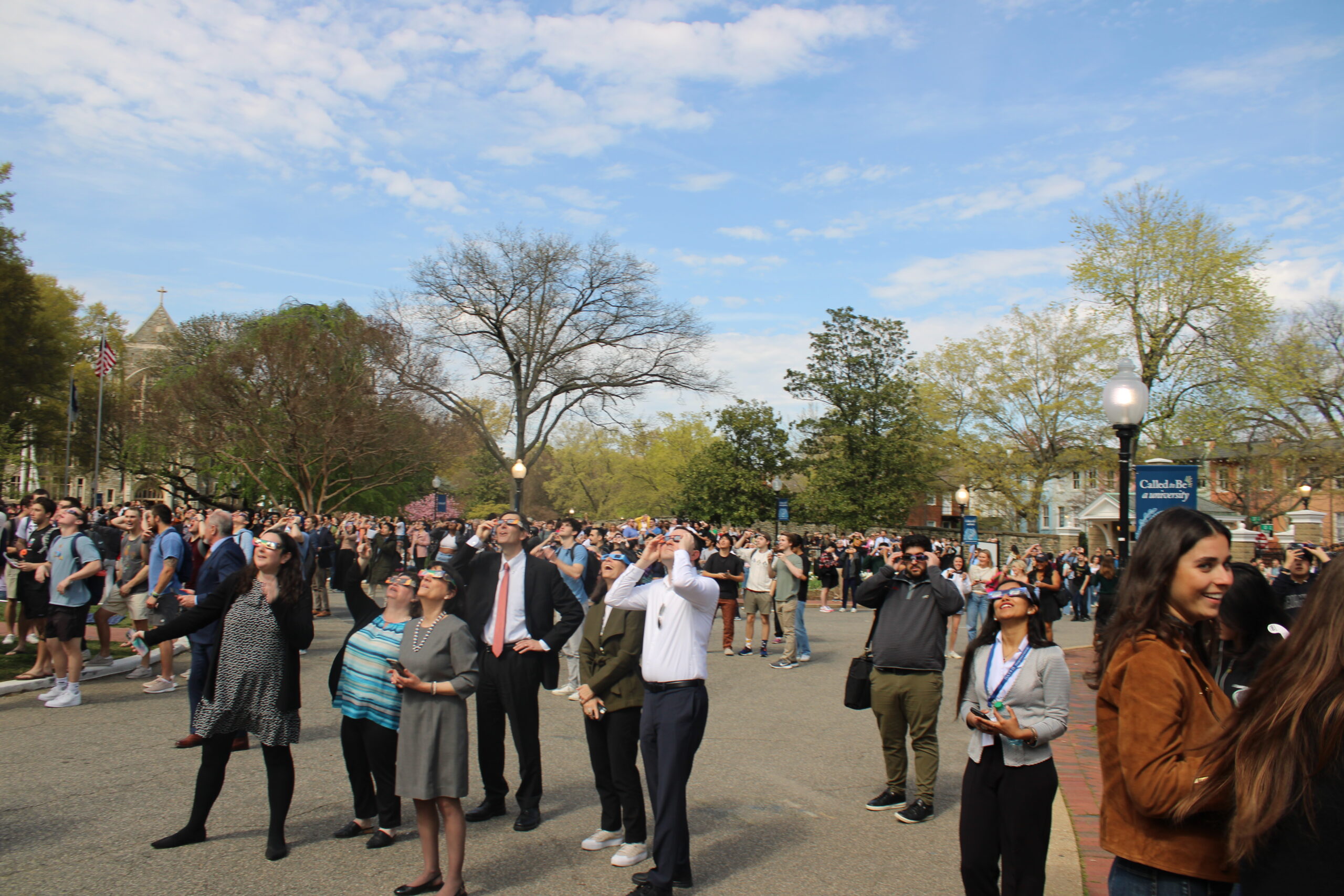Students, faculty, and probably even Jack the Bulldog stopped and stared as the sky darkened, and the moon partially blocked the sun on Monday afternoon. Georgetown students, including the hundreds gathered on Healy Lawn, were some of the millions who took a moment to appreciate the rare solar eclipse.
“Everybody just paused their classes, paused their life, to do it together. School stopped,” Rachel Li (CAS ’24) said.
In D.C., the moon blocked approximately 89% of the sun, and students all over campus clapped as the eclipse reached its peak at 3:20 p.m. The Astronomical Society specifically invited students to join them on the front lawn.
“We’ve been thinking about this eclipse for years now, waiting for it to happen,” Sophia Chang (SFS’24), the co-president of the Astronomical Society, said. To prepare for the event, they taught their members how to use solar scopes and explained the science behind the solar eclipse, allowing the club to table in front of Healy Hall and answer questions from the student body on the day of the eclipse. The club also received 300 pairs of glasses from the DC Space Grant Consortium, which they distributed freely to members and non-members alike.
“We believe that space should be accessible and democratized,” Chang said. The Astronomical Society used the eclipse to promote their petition calling on the university to restore the Heyden Observatory and expand space studies on campus.
“It was really cool seeing the whole community together on campus in one spot, looking at the eclipse, and even people who are not members of the Georgetown community, just seeing them all come and congregate on the front lawn was really cool,” Anya Singh (MSB ’27) said.
Students gathered in large groups in a variety of places beyond the front lawn, including Red Square, the Leavey esplanade, and even in the middle of Leavey bridge.
“It was perfect. The weather just happened to be really nice today,” Li said. “It was one of those moments that, seeing everyone have fun with it, reminded me of the joy of being a college student and being on campus together.”
For some, the eclipse was a sign of community, for others it was a business opportunity. Students in Red Square, in front of Leo O’Donovan dining hall, and walking around campus sold eclipse glasses, an operation that first began in 2017.
“I was in eighth grade at the time and I remember how hard it was to get those solar eclipse glasses,” the mastermind Stephen Souder (MSB ’27) said. “I wrote a reminder in my phone when I was 13, basically setting the reminder to go off in February of 2024, telling myself to buy solar eclipse glasses.”
One day, as Souder was sitting at his desk working, that reminder went off.
“I just jumped on it, ordered 5000 pairs,” he said.
Souder sold 4000 pairs in bulk to schools, golf courses, and stores. Then he recruited his friends to sell the remaining thousand on campus — one pair for five dollars or three for 10 dollars. Even this helped bring students together, as they teamed up to take advantage of the deal.
“Our professor let us take a break from lab to go see the eclipse. One person had a pair of glasses, and she let everyone borrow them to take a look,” Claire Auslander (NHS ’26) said.
The celestial show also helped students to feel closer to home, as people watched from across the country.
“My whole family was watching it in New Jersey… and then my brother was in New York watching it,” Li said. “It was a nice little family bonding moment. We were all doing the same thing at the same time, even though we were in different places.”
The next total eclipse over North America won’t be until 2033 and even then it will only be visible in Alaska. The soonest D.C. could see another one will be August 2045.
“It’s a long way out there, but I might have to set a reminder,” Souder said.





